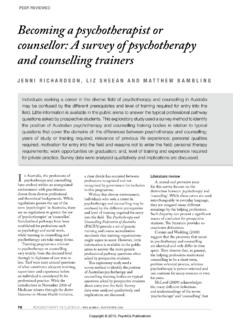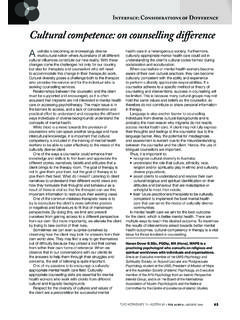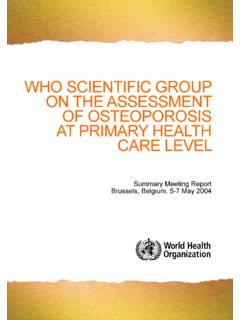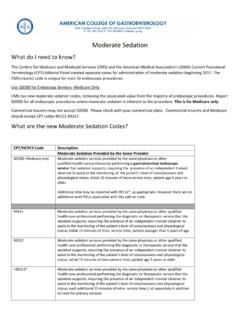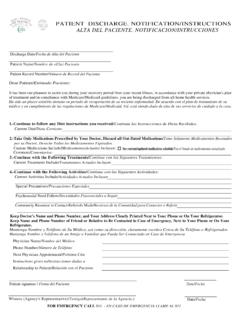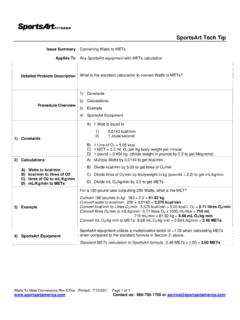Transcription of Interpersonal Psychotherapy: An overview
1 46 psychotherapy IN AUSTRALIA VOL 14 NO 3 MAY 2008 Interpersonal psychotherapy : An overviewMICHAEL ROBERTSON, PAUL RUSHTON and CHRISTOPHER WURM Despite inclusion in Federal Government funded Medicare programs such as Better Outcomes and Better Access the profile of Interpersonal psychotherapy (IPT) in teaching programs across Australia is low, and psychotherapists often know little about IPT other than it is evidence-based. This paper provides an overview of the structure and process of Interpersonal psychotherapy . While there are more authoritative reviews on IPT, on the whole these reviews and IPT in general have not pervaded the psyche or reading of the average Australian psychotherapy psychotherapy (IPT) is a time-limited, interpersonally focused, psychodynamically informed psychotherapy that has the goals of symptom relief and improving Interpersonal functioning.
2 IPT is concerned with the Interpersonal context the relational factors that predispose, precipitate and perpetuate the patient s distress. Within IPT Interpersonal relationships are the focus of therapeutic attention as the means to bring about change, with the aim of helping patients to improve their Interpersonal relationships or change their expectations about them. In addition, the treatment also aims to assist patients to improve their social support network so that they can better manage their current Interpersonal distress (Stuart & Robertson, 2003).The history and evolution of IPT From the late 1970 s American psychiatry turned its focus to evidence-based medicine, in particular the randomised control trial.
3 The traditional clinical view was that most interventions seemed to work for depression. With the advent of antidepressant medications, and their apparent effectiveness in treating depression, it was necessary to compare these with the established psychological therapies. The timeframe for the therapy control treatment was determined by the research design, rather than being drawn from any evidence base. As such, the traditional assumption that IPT was of 16 weeks duration was based upon academic considerations, not clinical order to standardise what seemed to comprise the elements of good psychotherapy , researchers led by Gerald Klerman devised a treatment that integrated what was thought to be the essence of medical psychotherapy and constructed a treatment programme that would fit neatly within a treatment trial.
4 Klerman and colleagues believed that, given depression invariably had an impact on communication and Interpersonal interactions, as well as consequences for the patient s marriage, family, work and community activities, this was a worthy focus for psychotherapeutic intervention. The development of IPT therefore did not follow the conventional path of a theory leading to practice. However, several theories are considered influential in the development of IPT including the attachment theory of Bowlby and his successors, and communication theory (Stuart & Robertson, 2003). Whilst IPT made no assumptions about aetiology of depression, the social risk factors for depression as identified by Brown and Harris (1978), Paykel, Weissman & Prusoff (1978), and Henderson (1988) also influenced the development of the first appeared as the control treatment for studies investigating the efficacy of antidepressant medications (Klerman, Weissman, Rounsaville & Chevron, 1984).
5 Like many serendipitous findings in science, IPT was found to be of comparable efficacy to medication in these studies and earned itself a place alongside Aaron Beck s Cognitive Behaviour Therapy (CBT) as a credible candidate for investigation as an active treatment. For many years IPT remained little known outside academic circles in the USA and Europe, unlike CBT. In the late 1990 s, there was an increased interest in IPT amongst clinicians. This culminated in the formation of the International Society for IPT (ISIPT) in 2000. Since that time, dissemination of IPT has increased momentum within some mental health circles. The recent inclusion of IPT in the focused psychological strategies for the Medicare funded Better Outcomes psychotherapy IN AUSTRALIA VOL 14 NO 3 MAY 200847in Mental Health and Better Access to Mental Health programs has resulted in increased exposure for and interest in IPT across Australia.
6 The structure of IPTT here are five distinct phases in the IPT approach; assessment, the initial sessions, middle sessions, termination sessions or conclusion of acute treatment, and maintenance sessions. In the assessment phase, the therapist completes a standard clinical interview and determines the suitability of IPT for the patient. If the patient is suitable the therapist proceeds through the initial sessions of IPT including socialising the patient to IPT, which is referred to as creating the IPT focus , completing an Interpersonal inventory, developing an Interpersonal formulation and contracting the patient to a specific number of sessions.
7 In the middle sessions, the therapist and patient address the relevant problem areas (ideally one but can be more more) using key IPT techniques. During the termination phase, or what is often referred to as the conclusion of acute treatment phase, the therapist and patient review progress in the problem areas and plan for future problems. Maintenance sessions can be conducted to prevent relapse or to work through any remaining problems, but only after a new contract is negotiated. The focus should remain on Interpersonal issues and the short to mid term nature of IPT should be kept in mind. Each of these stages is now explained in more The initial assessment for IPT suitabilityThe assessment phase of IPT determines whether the patient is a suitable candidate for IPT.
8 Non-specific issues are considered such as suitability for any psychological intervention, motivation for change, ego strength, adequacy on non-psychological treatments, and so forth. IPT is concerned with the Interpersonal context the relational factors that predispose, precipitate and perpetuate the patient s : Savina HopkinsStuart and Robertson (2003) suggest that the following characteristics can increase the likelihood that patients will benefit from IPT: a relatively secure attachment style; the ability to relate a coherent narrative of their Interpersonal network and specific Interpersonal interactions; a specific Interpersonal focus for distress; a good social support system.
9 Perhaps the most critical judgement is whether the IPT intervention resonates with the patient s view of their psychological distress. The assessment phase ends with a treatment contract with the patient to proceed with a specific number of IPT sessions and to work on one or more specific Interpersonal problems. b. The initial sessionsThe initial sessions of IPT include a number of specific tasks. The primary goals are to develop an Interpersonal formulation, which is a detailed hypothesis about why the patient is having Interpersonal difficulties, and to gauge the patient s social support in general. The Interpersonal formulation is a modification of Engel s Biopsychosocial model, integrating the four IPT problem areas.
10 Intrinsic to this process is the development of an Interpersonal Inventory (IPI). The IPI functions as the main 48 psychotherapy IN AUSTRALIA VOL 14 NO 3 MAY 2008structural component of this process with a specific focus of the patient and therapist on:1) current relationships;2) the history of the patient s current problems as applied to that relationship;3) information that is relevant to the process of resolving the problem area, for example attachment style, communication style, and patterns of interaction;4) setting appropriate treatment goals. (See Figure 1.)With the completion of the Interpersonal inventory, an Interpersonal focus is formulated using the four IPT problem The middle sessionsIn the middle sessions of IPT the therapist and patient address one or more of the four IPT problem areas using key IPT techniques.
